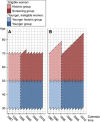Effect of organised mammography screening on stage-specific incidence in Norway: population study
- PMID: 26835975
- PMCID: PMC4782212
- DOI: 10.1038/bjc.2016.8
Effect of organised mammography screening on stage-specific incidence in Norway: population study
Abstract
Background: We aimed to estimate the effect of organised mammography screening on breast cancer stage distribution by comparing changes in women eligible for screening, based on birth cohort, to the concurrent changes in younger, ineligible women.
Methods: In an open cohort study in Norway, which introduced national mammography screening county-by-county from 1995 to 2004, we identified women (n=49 883) diagnosed with in situ or invasive breast cancer (ICD10 codes: D05 or C50) during the period 1987-2011 and born between 1917 and 1980. We estimated relative incidence rate ratios (rIRRs) comparing the development in the screening vs historic group to the younger vs younger historic group.
Results: Including the compensatory drop, eligible women experienced a 68% higher increase in localised cancers (rIRR=1.68, 95% confidence interval (CI): 1.51-1.87) than younger women, while the increase in incidence of advanced cancers was similar (rIRR=1.11, 95% CI: 0.90-1.36). Excluding the prevalence round, eligible women experienced a 60% higher increase in localised cancers (rIRR=1.60, 95% CI: 1.42-1.79), while the increase in incidence of advanced cancers remained similar (rIRR=1.08, 95% CI: 0.86-1.35).
Conclusions: Introduction of organised mammography screening was followed by a significant increase in localised and no change in advanced-stage cancers in women eligible for screening relative to younger, ineligible women.
Figures


Similar articles
-
The contribution of mammography screening to breast cancer incidence trends in the United States: an updated age-period-cohort model.Cancer Epidemiol Biomarkers Prev. 2015 Jun;24(6):905-12. doi: 10.1158/1055-9965.EPI-14-1286. Epub 2015 Mar 18. Cancer Epidemiol Biomarkers Prev. 2015. PMID: 25787716 Free PMC article.
-
Effect of organized mammography screening on breast cancer mortality: A population-based cohort study in Norway.Int J Cancer. 2019 Feb 15;144(4):697-706. doi: 10.1002/ijc.31832. Epub 2018 Oct 22. Int J Cancer. 2019. PMID: 30144028
-
Integration of 3D digital mammography with tomosynthesis for population breast-cancer screening (STORM): a prospective comparison study.Lancet Oncol. 2013 Jun;14(7):583-9. doi: 10.1016/S1470-2045(13)70134-7. Epub 2013 Apr 25. Lancet Oncol. 2013. PMID: 23623721
-
Abbreviated Magnetic Resonance Imaging (MRI) for Breast Cancer Screening: Rationale, Concept, and Transfer to Clinical Practice.Annu Rev Med. 2019 Jan 27;70:501-519. doi: 10.1146/annurev-med-121417-100403. Annu Rev Med. 2019. PMID: 30691370 Review.
-
Mammography screening and breast cancer biology in African American women--a review.Cancer Detect Prev. 2002;26(3):180-91. doi: 10.1016/s0361-090x(02)00062-4. Cancer Detect Prev. 2002. PMID: 12269764 Review.
Cited by
-
The impacts of public mammography screening on the relationship between socioeconomic status and cancer stage.SSM Popul Health. 2016 Aug 3;2:502-511. doi: 10.1016/j.ssmph.2016.07.002. eCollection 2016 Dec. SSM Popul Health. 2016. PMID: 29349166 Free PMC article.
-
The impact of mammography screening programmes on incidence of advanced breast cancer in Europe: a literature review.BMC Cancer. 2018 Sep 3;18(1):860. doi: 10.1186/s12885-018-4666-1. BMC Cancer. 2018. PMID: 30176813 Free PMC article. Review.
-
A comparison of breast cancer incidence and cancer stages before and after the introduction of the Austrian national breast cancer screening program in the federal state of Salzburg : Real-world data from the Tumor Registry Salzburg.Wien Klin Wochenschr. 2025 Apr;137(7-8):205-213. doi: 10.1007/s00508-025-02508-8. Epub 2025 Apr 1. Wien Klin Wochenschr. 2025. PMID: 40167619 Free PMC article.
-
Personalized screening based on risk and density: prevalence data from the RIBBS study.Radiol Med. 2025 May;130(5):740-752. doi: 10.1007/s11547-025-01981-5. Epub 2025 Mar 21. Radiol Med. 2025. PMID: 40117106 Free PMC article.
-
Assessment of Breast Cancer Mortality Trends Associated With Mammographic Screening and Adjuvant Therapy From 1986 to 2013 in the State of Victoria, Australia.JAMA Netw Open. 2020 Jun 1;3(6):e208249. doi: 10.1001/jamanetworkopen.2020.8249. JAMA Netw Open. 2020. PMID: 32573707 Free PMC article.
References
-
- Autier P (2013) Mammography screening before introduction of the national breast screening programme in Norway. Int J Cancer 132: 1721–1722. - PubMed
-
- Biesheuvel C, Barratt A, Howard K, Houssami N, Irwig L (2007) Effects of study methods and biases on estimates of invasive breast cancer overdetection with mammography screening: a systematic review. Lancet Oncol 8: 1129–1138. - PubMed
-
- Black WC, Welch HG (1993) Advances in diagnostic imaging and overestimations of disease prevalence and the benefits of therapy. N Engl J Med 328: 1237–1243. - PubMed
Publication types
MeSH terms
LinkOut - more resources
Full Text Sources
Other Literature Sources
Medical

